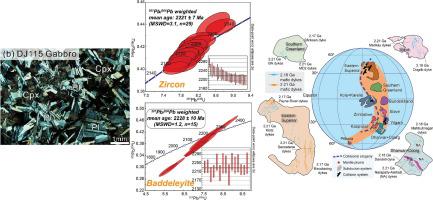当前位置:
X-MOL 学术
›
Geosci. Front.
›
论文详情
Our official English website, www.x-mol.net, welcomes your
feedback! (Note: you will need to create a separate account there.)
Breakup of the Neoarchean supercontinent Kenorland: Evidence from zircon and baddeleyite U-Pb ages of LIP-related mafic dykes in the Coorg Block, southern India
Geoscience Frontiers ( IF 8.5 ) Pub Date : 2024-02-05 , DOI: 10.1016/j.gsf.2024.101804 Cheng-Xue Yang , M. Santosh , Jarred Lloyd , Stijn Glorie , Y. Anilkumar , K.S. Anoop , Pin Gao , Sung-Won Kim
Geoscience Frontiers ( IF 8.5 ) Pub Date : 2024-02-05 , DOI: 10.1016/j.gsf.2024.101804 Cheng-Xue Yang , M. Santosh , Jarred Lloyd , Stijn Glorie , Y. Anilkumar , K.S. Anoop , Pin Gao , Sung-Won Kim

|
The Coorg Block in southern Peninsular India is one of the oldest crustal blocks on Earth that preserves the evidence for continental crust formation during the Paleo-Mesoarchean through subduction-related arc magmatism, followed by granulite facies metamorphism in the Mesoarchean. In this study, we report for the first time, the ‘bar codes’ of a major Paleoproterozoic Large Igneous Province in the Coorg Block through the finding of mafic dyke swarms. The gabbroic dykes from the Coorg Block, dominantly composed of plagioclase-pyroxene assemblage, show a restricted range in SiO values of 50.04–51.27 wt.%, and exhibit a sub-alkaline tholeiitic nature. These rocks show relatively flat LREE and constant HREE patterns and lack obvious Eu anomalies. Trace element modeling suggests that the dyke swarm was fed from a melt that originated at a shallow mantle level in the spinel stability field. Zircon grains are rare in the gabbro samples and those separated from two samples yielded Pb/Pb weighted mean dates of 2214 ± 12 Ma and 2221 ± 7 Ma. The grains show magmatic features with depleted LREE and enriched HREE and positive Ce and negative Eu anomalies. Baddeleyite grains were dated from five gabbro samples which yielded Pb/Pb weighted mean ages ranging between 2217 ± 7 Ma and 2228 ± 10 Ma. The combined data show a clear age peak at ca. 2.2 Ga. The mafic dykes in the Coorg Block show geochemical similarities with ca. 2.2 Ga mafic dyke swarms in different regions of the Dharwar and other cratons in Peninsular India and elsewhere on the globe. The data also support the inference that the global mafic magmatism at ca. 2.2 Ga was linked with intracontinental rifting of the Archean cratons through mantle upwelling or plume activity. We correlate the mafic dyke swarms in the Coorg Block with attempted rifting of the Neoarchean supercontinent Kenorland.
中文翻译:

新太古代超大陆凯诺兰的分裂:印度南部库格地块中与 LIP 相关的基性岩脉的锆石和斜锆石 U-Pb 年龄的证据
印度半岛南部的库格地块是地球上最古老的地壳地块之一,它保存了古中太古代时期通过与俯冲相关的弧岩浆作用以及随后的中太古代麻粒岩相变质作用形成大陆地壳的证据。在这项研究中,我们通过发现镁铁质岩脉群,首次报告了库格地块古元古代大型火成岩省的“条形码”。库格地块的辉长岩脉主要由斜长石-辉石组合组成,SiO2 值限制在 50.04–51.27 wt.% 范围内,并表现出亚碱性拉斑斑岩性质。这些岩石表现出相对平坦的轻稀土元素和恒定的重稀土元素模式,并且缺乏明显的铕异常。微量元素模型表明,堤群是由源自尖晶石稳定场浅地幔层的熔体供给的。辉长岩样品中的锆石颗粒很少,从两个样品中分离出来的锆石颗粒产生的 Pb/Pb 加权平均日期为 2214 ± 12 Ma 和 2221 ± 7 Ma。颗粒显示出贫轻稀土和富重重稀土以及正 Ce 和负 Eu 异常的岩浆特征。从五个辉长岩样品中对斜锆石颗粒进行了测年,得出的 Pb/Pb 加权平均年龄范围在 2217 ± 7 Ma 和 2228 ± 10 Ma 之间。综合数据显示,明显的年龄峰值约为 10 岁。 2.2 Ga。库格地块中的镁铁质岩脉显示出与约 2.2 Ga 的地球化学相似性。 2.2 Ga基性岩墙群分布在印度半岛和全球其他地区的达瓦尔和其他克拉通的不同地区。这些数据还支持这样的推论,即全球镁铁质岩浆作用位于大约。 2.2 Ga 通过地幔上涌或地幔柱活动与太古代克拉通的陆内裂谷有关。 我们将库格地块中的镁铁质岩墙群与新太古代超大陆凯诺兰的裂谷联系起来。
更新日期:2024-02-05
中文翻译:

新太古代超大陆凯诺兰的分裂:印度南部库格地块中与 LIP 相关的基性岩脉的锆石和斜锆石 U-Pb 年龄的证据
印度半岛南部的库格地块是地球上最古老的地壳地块之一,它保存了古中太古代时期通过与俯冲相关的弧岩浆作用以及随后的中太古代麻粒岩相变质作用形成大陆地壳的证据。在这项研究中,我们通过发现镁铁质岩脉群,首次报告了库格地块古元古代大型火成岩省的“条形码”。库格地块的辉长岩脉主要由斜长石-辉石组合组成,SiO2 值限制在 50.04–51.27 wt.% 范围内,并表现出亚碱性拉斑斑岩性质。这些岩石表现出相对平坦的轻稀土元素和恒定的重稀土元素模式,并且缺乏明显的铕异常。微量元素模型表明,堤群是由源自尖晶石稳定场浅地幔层的熔体供给的。辉长岩样品中的锆石颗粒很少,从两个样品中分离出来的锆石颗粒产生的 Pb/Pb 加权平均日期为 2214 ± 12 Ma 和 2221 ± 7 Ma。颗粒显示出贫轻稀土和富重重稀土以及正 Ce 和负 Eu 异常的岩浆特征。从五个辉长岩样品中对斜锆石颗粒进行了测年,得出的 Pb/Pb 加权平均年龄范围在 2217 ± 7 Ma 和 2228 ± 10 Ma 之间。综合数据显示,明显的年龄峰值约为 10 岁。 2.2 Ga。库格地块中的镁铁质岩脉显示出与约 2.2 Ga 的地球化学相似性。 2.2 Ga基性岩墙群分布在印度半岛和全球其他地区的达瓦尔和其他克拉通的不同地区。这些数据还支持这样的推论,即全球镁铁质岩浆作用位于大约。 2.2 Ga 通过地幔上涌或地幔柱活动与太古代克拉通的陆内裂谷有关。 我们将库格地块中的镁铁质岩墙群与新太古代超大陆凯诺兰的裂谷联系起来。


















































 京公网安备 11010802027423号
京公网安备 11010802027423号